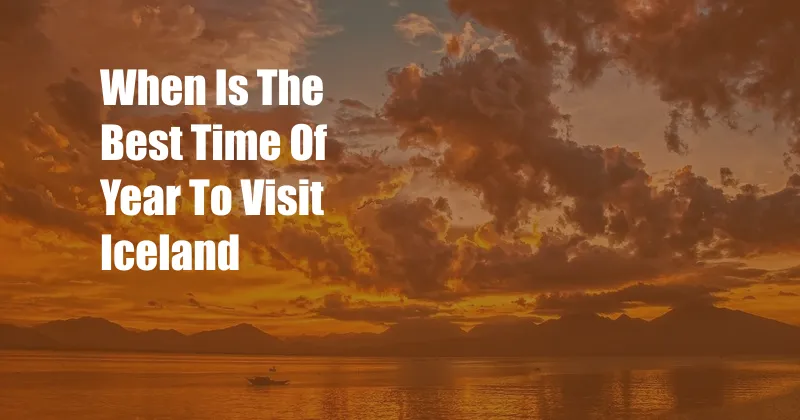
When to Visit Iceland: The Ultimate Guide to Northern Lights, Midnight Sun, and Dreamy Landscapes
As I stood on the edge of a glacier, a surreal glow danced across the sky above me. The Northern Lights, a celestial marvel, painted the heavens in hues of green and violet, an unforgettable display that transcended time and space. It was a moment that forever etched Iceland into my heart, and it was all because I chose the perfect time to visit.
When planning an Icelandic adventure, the timing is everything. Nature’s rhythms shape the island’s character, promising unique experiences throughout the year. From the ethereal glow of the midnight sun to the magical dance of the Northern Lights, Iceland unveils its wonders in a tapestry of seasons.
When is the Best Time to See the Northern Lights?
The Northern Lights, or Aurora Borealis, are a natural phenomenon that occurs when charged particles from the sun interact with the Earth’s magnetic field. Iceland’s remote location and clear night skies make it an ideal destination to witness this mesmerizing cosmic show.
The best time to see the Northern Lights in Iceland is during the winter months, from September to April. During this period, the nights are longer, and the sky remains dark for an extended period, increasing your chances of spotting the elusive lights.
When is the Best Time to See the Midnight Sun?
The midnight sun is a peculiar celestial occurrence that happens during the summer months in Iceland, from May to August. As the Earth tilts on its axis, the sun lingers above the horizon throughout the night, creating a perpetual twilight.
The midnight sun is a magical time to explore Iceland. You can hike under a surreal, never-ending sunlight, marveling at the vibrant landscapes, and chase waterfalls under a never-ending golden hour.
Seasonal Highlights and Activities
Each season in Iceland offers a unique array of activities and experiences. From hiking and whale watching to ice cave exploration and glacier trekking, there’s something for every adventure seeker.
- Spring (April-May): As winter’s grip loosens, Iceland awakens with blooming flowers and migrating birds. This season is ideal for wildlife spotting and exploring the Highlands’ snow-covered peaks.
- Summer (June-August): With the midnight sun illuminating the land, summer is a time of endless exploration. Hiking trails lead to breathtaking waterfalls, glaciers invite you to embark on thrilling adventures, and whale watching tours offer glimpses of majestic creatures.
- Autumn (September-October): As the days grow shorter, Iceland transforms into a fiery palette of reds and golds. This season marks the return of the Northern Lights and offers opportunities for cozy cabin retreats and scenic drives.
- Winter (November-March): When snow blankets the land, Iceland becomes a winter wonderland. Ice caves reveal their frozen beauty, snowmobiling and dog sledding offer exhilarating experiences, and the Northern Lights paint the sky in vibrant hues.
Tips for Optimal Icelandic Experiences
To make the most of your Icelandic adventure, consider these expert tips:
- Plan ahead: Book accommodations and activities in advance, especially during peak season.
- Be weather-prepared: Iceland’s weather can be unpredictable, so pack clothing for all conditions.
- Respect the environment: Iceland’s natural beauty is fragile. Stay on marked trails and avoid disturbing wildlife.
- Stay flexible: Be prepared for itinerary changes due to weather or unforeseen circumstances.
- Embrace the unexpected: Iceland offers endless opportunities for spontaneous adventures. Keep an open mind and embrace the surprises that come your way.
By following these tips, you can maximize your Icelandic experience, creating memories that will last a lifetime.
Frequently Asked Questions
Q: When is Iceland the least crowded?
A: Iceland is generally less crowded during the shoulder seasons (April-May and September-October).
Q: Can I see both the Northern Lights and the midnight sun on the same trip?
A: Yes, but it requires careful planning. Visit Iceland in the shoulder season (April-May or September-October) to experience both phenomena.
Q: What are the best places to see the Northern Lights in Iceland?
A: Isolated locations away from light pollution offer the best chances of spotting the Northern Lights. Consider visiting Þingvellir National Park, Lake Mývatn, or the Snæfellsnes Peninsula.
Conclusion
The choice of when to visit Iceland depends on your travel preferences and the experiences you seek. Whether you long to witness the celestial dance of the Northern Lights or revel in the endless sunlight of the midnight sun, Iceland offers an adventure like no other. By considering the seasonal highlights, following expert advice, and embracing the unexpected, you can create a truly unforgettable Icelandic experience.
Are you ready to embark on an Icelandic journey that will ignite your soul and create memories that will last a lifetime? Plan your adventure today and let Iceland’s wonders enchant you.